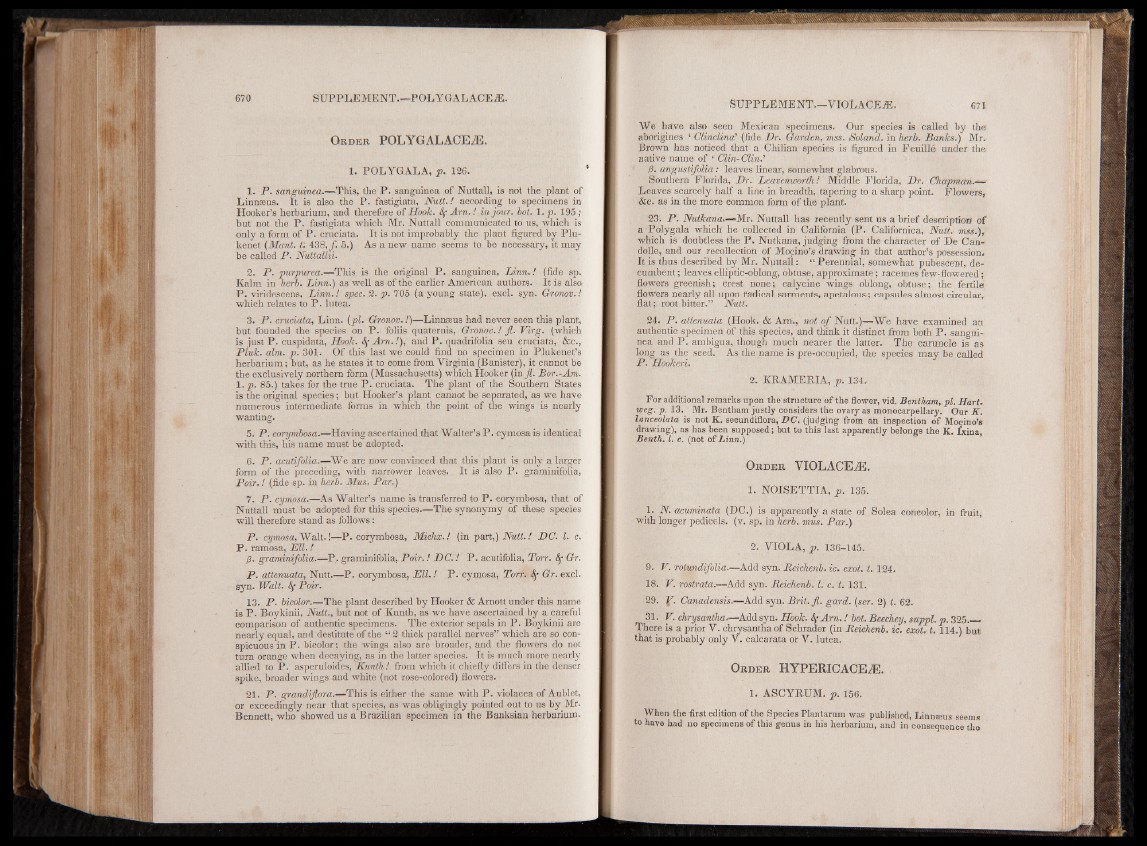
Or d e r POLYGALACEiE.
1. POLYGALA, p. 126. ’
1. P . sanguined.—This, the P. sanguinea of Nuttall, is not the plant of
Linnaeus. It is also the P. fastigiata, Nutt.! according to specimens in
Hooker’s herbarium, and therefore of Hook. Sf A rn .! in jour. hot. 1. p. 195 ;
hut not the P. fastigiata which Mr. Nuttall communicated to us, which is
only a form of P. cruciata. It is not improbably the plant figured by Plu-
kenet (Mant. t: 438,/. 5.) As a new name seems to be necessary, it may
be called P . Nuttallii.
2. P. purpurea.—This is the original P. sanguinea, Linn.! (fide sp.
Kalm in herb. Linn.) as well as of the earlier American authors. It is also
P . viridescens, Linn.! spec. 2. p. 705 (a young state), excl. syn. Gronov.!
which relates to P. lutea.
3. P . cruciata, Linn. (pi. Gronov.!)—Linnaeus had never seen this plant,
but founded the species on P. foliis quaternis, Gronoo.! jl. Virg. (which
is just P. cuspidata, Hook. A m .!), and P. quadrifolia seu cruciata, &c.,
Pluk. aim. p, 301. Of this last we could find no specimen in Plukenet’s
herbarium; but, as he states it to eome from Virginia (Banister), it cannot be
the exclusively northern form (Massachusetts) which Hooker (in jl. Bor.-Am.
1. p. 85.) takes for the true P. cruciata. The plant of the Southern States
is the original species; but Hooker’s plant cannot be separated, as we have
numerous intermediate forms in which the point of the wings is nearly
wanting.
5. P . corymbosa.—Having ascertained that Walter’s P. cymosa is identical
with this, ms name must be adopted.
6. P . acutifolia.—We are now convineed.fliat this plant is only a larger
form of the preceding, with narrower leaves. It is also P. graminifolia,
Pair.! (fide sp. in herb. Mus. Par.)
7. P . cymosa.—As Walter’s name is transferred to P. corymbosa, that of
Nuttall must be adopted for this species.—The synonymy of these species
will therefore stand as follows:
P . cymosa, W alt.!—P. corymbosa, Michx.! (in part,) Nutt.! DC. 1. c.
P. ramosa, E ll.!
O. graminifolia.—P, graminifolia, Pair.! DC.! P. acutifolia, Torr. 8f Gr.
P. attenuata, Nutt.—P. corymbosa, E ll.! P. cymosa, Tom Gr. excl.
syn. Walt, bf Poir.
13. P . bicolor.—The plant described by Hooker & Arnott under this name
is P. Boykinii, Nutt., but not of Kunth, as we have ascertained by a careful
comparison of authentic specimens. The exterior sepals in P. Boykinii are
nearly equal, and destitute of the “ 2 thiek parallel nerves” which are so conspicuous
in P. bicolor; the wings also are broader, and the flowers do not
turn orange when decaying, as in the latter species. It is much more nearly
allied to P. asperuloides, Kunth! from which it chiefly differs in the denser
spike, broader wings and white (not rose-colored) flowers.
21. P . grandiflora.—This is either the same with P. violacea of Aublet,
or exceedingly near that species, as was obligingly pointed out to us by Mr.
Bennett, who showed us a Brazilian specimen in the Banksian herbarium.
We have also seen Mexican specimens. Our species is called by the'
aborigines ‘ Clindina' (fide Dr. Garden, mss. Soland. in herb. Banks.) Mr.
Brown has noticed that a Chilian species is figured in Feuille under the
native name of ‘ Clin-din.’
0. angustifolia: leaves linear, somewhat glabrous.
Southern Florida, Dr. Leavenworth! Middle Florida, Dr. Chapman
Leaves scarcely half a line in breadth, tapering to a sharp point. Flowers,
&c. as in the more common form of the plant.
23. P . Nutkana.—Mr. Nuttall has recently sent us a brief description of
a Polygala which he collected in California (P. Californica, Nutt, mss.),
which is doubtless the P, Nutkana, judging from the character of De Candolle,
and our recollection of Mocino’s drawing in that author’s possession.
It is thus described by Mr. Nuttall: “ Perennial, somewhat pubescent, decumbent
; leaves elliptic-oblong, obtuse, approximate; racemes few-flowered;
flowers greenish; crest none; calycine wings oblong, obtuse; the fertile
flowers nearly all upon radical sarments, apetalous; capsules almost circular,
flat; root bitter.” Nutt.
24. P . attenuata (Hook. & Arn., not of Nutt.)—We have examined an
authentic specimen of this species, and flunk it distinct from both P . sangoi-
nea and P. ambigua, though much nearer the latter. The caruncle is as
long as the seed. As the name is pre-occupied, the species may be called
P . Hookeri.
2. KRAMERIA, p. 134.
For additional remarks upon the structure of the flower, vid. Bentham, pi. Hart-
weg. p. 13. Mr. Bentham justly considers the ovary as monocarpellary. Our K.
lanceolata is not K. secundiflora, DC. (judging from an inspection of Mogino’s
drawing), as has been supposed; but to this last apparently belongs the E. Ixina,
Benth. 1. c. (not of Linn.)
Or d e r YIOLACEjE.
1. NOISETTIA, p. 135.
1. N. acuminata (DC.) is apparently a state of Solea coneolor, in fruit,
with longer pedicels, (v. sp. in herb. mus. Par.)
2. VIOLA, p. 136-145.
9. V. rotundifolia.—Add syn. Reichenb. ic. exot. t. 124.
18. V. rostrata.—Add syn. Reichenb. 1. c. t. 131.
29. Y- Canadensis.—Add syn. Brit. Jl. gard. (ser. 2) t. 62.
31. V. chrysantha.—Add syn. Hook. Sf A rn .! bot. Beechey, suppl. p. 325._
There is a prior V. chrysantha of Schrader (in Reichenb. ic. exot, t. 114.) but
that is probably only V. calcarata or V. lutea.
Or d e r HYPERICACEiE.
1. ASCYRUM. p. 156.
When the first edition of the Species Plantarum was published, Linnaeus seems
to have had no specimens of this genus in his herbarium, and in consequence the